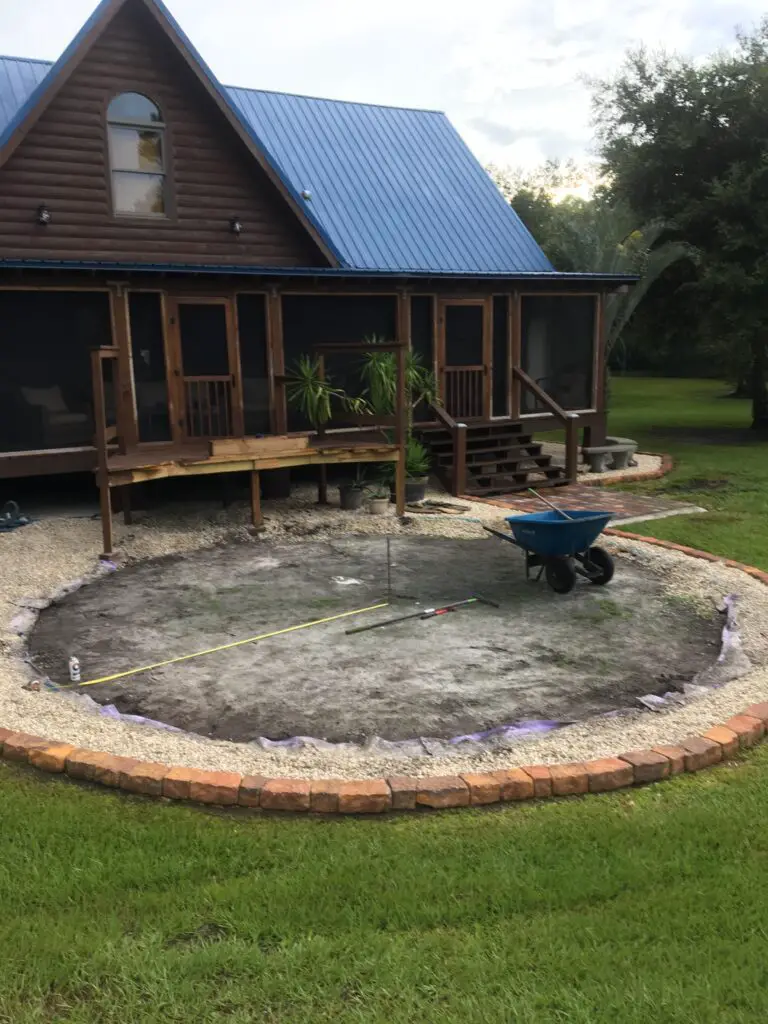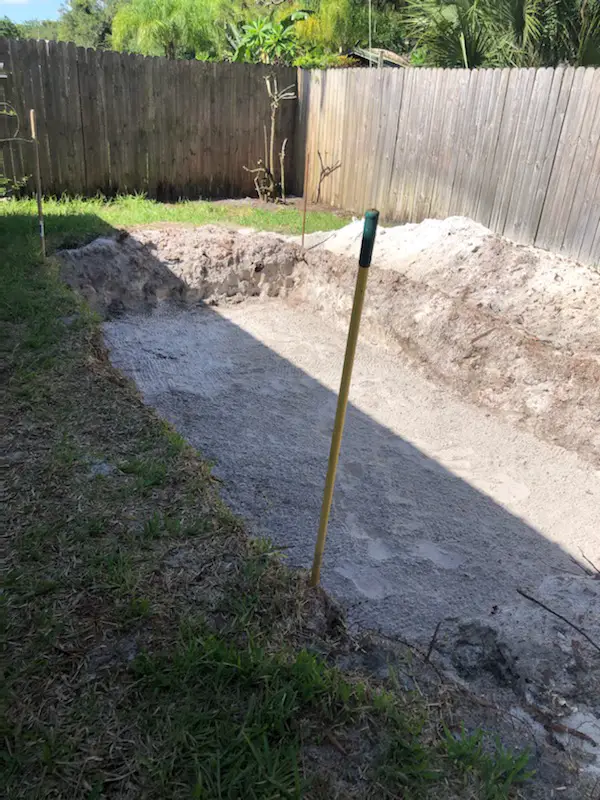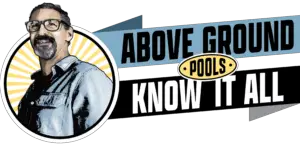Above-ground swimming pools are now installed in any size yard in any type of neighborhood. Most don’t care a lot about where to put the pool if they have some acres or have a big yard.
Some have small yards or backyards full of components that don’t give them a lot of room for a new pool. This article is will help you determine how much space you will need for an above-ground pool.
Most pool installers won’t come out and look at the yard first, so whether you are installing the pool yourself or having a professional do it, you’re going to want to know how much room you need.
The actual footprint an above-ground pool takes up is about one foot bigger than the size of the pool. The footprint for ovals is more as you have to add for the buttress structures. It’s also good to have space to walk all the way around the pool and not be too close to the home to prevent rain run-off from the roof.
FIVE THINGS THAT AFFECT HOW MUCH ROOM AN ABOVE GROUND POOL NEEDS
If you are thinking of putting up an above-ground pool in a tight spot, it’s good to consider these things.
1 Add one foot to the size of the pool

An above-ground pool has a frame that keeps the wall more stable. This frame takes up some room all the way around the pool.
If you have a 24’ round pool(most common size) for example, it will have approximately 24’ round of swim area. This means that the wall of the pool will be about 24’ in diameter, then the frame will stick out beyond that.
Every model of above ground pool has different dimensions for the frame parts (uprights and top rails). More basic models will have upright supports only two inches thick and nicer models can have 4-5 inch thick uprights.
So, using a 24’ round as an example, if the uprights of the frame are four inches thick, then the actual footprint of the pool will be 24’ plus four inches, times two. You have to times the thickness of the uprights by two as there are uprights all around the pool.
With the above example, the overall footprint of the 24’ round pool with four-inch thick uprights will be 24’, 8”.
In the 36 years of installing all types of above grounds, I have only seen maybe two uprights that were thicker than five inches, so this is why I say to consider the footprint of your pool being the size plus one foot.
Using the above example again, the footprint or actual area that the pool will take up is 25’ around.
2 Rainwater run-off from the house roof
I have installed pools inches away from the back wall of the home. While I don’t advise this, it can be done with no issues as long as rainwater cannot run off of the roof and into the pool.
Look at your roofline and see if rainwater comes down where you are considering installing the pool. It’s always best to keep the pool more than five feet away from the home structure, but if you don’t have room, then you may have no choice but to go closer.
To be perfectly clear here “You don’t want rainwater to go into your pool from your home’s roof”. This will cause a lot of issues with keeping your pool’s water balanced.
If you have no choice, look into installing a gutter to divert the rainwater from where the pool is going.
3 Being able to walk around the pool
It’s very common for people to want to shove their new pool in the corner of their yard. I get that as you want to keep the yard space that you have.
Unless you have no choice, it’s best to leave space between your fence, outbuilding/shed, home, tall landscaping, or anything else that may be in your yard, and your pool.
Leaving at least enough space to walk around the outside of the pool will allow you to clean the pool easier and make sure that nothing is leaning against or growing against the pool wall.
And it’s usually aesthetically better if the pool isn’t “crammed” in the corner of the yard.
4 Permits, easements, and overhead power lines
Most don’t get permits for above-ground pools. If you do though, you will need to put the pool up in a “legal” spot. This means it will have to be away from your property lines by a certain amount and may have to be away from the house by an amount determined by your local building department.
Many people with small yards aren’t able to install their pool in a legal spot as many municipalities require 5-10 feet easements from back and side property lines and 3-10 feet off of the house.
Also, any overhead power lines running across your yard can be an issue for where you want the pool. In the US, every state requires that your pool is at least ten linear feet from the waterline of the pool. This is with ANY overhead power line including cable lines.
Linear means that if you took the power line and dropped it on the ground from where it is hanging, then your pool’s waterline will have to be ten feet away or more. This is a big restriction if your power line is running in the middle of your backyard as you will have to be far from it in both directions.
Many who don’t get a permit will make sure and put the pool in a legal spot just in case there is an issue with the government at a later date. Most don’t care.
5 Having room for the pump and filter
The pool’s equipment is placed somewhere beyond the pool and frame. It can be plumbed far away from the wall of the pool, but the vast majority of above-ground pool equipment (pump and filter) is placed directly next to the pool.
There are different pump and filter packs that take up different amounts of space. Almost all of them will fit nicely within a four-foot by four-foot area somewhere directly next to the pool.
It’s nice to have a lot of open space around the equipment so you can easily get to everything for service and maintenance, but if in a tight spot, a 4’x4’ area should work well.
OVAL POOLS REQUIRE MORE SPACE
Oval above ground swimming pools have buttresses which are protruding structures that keep the straight sides of the pool wall from pushing over when filled with water.
Think of a buttress as an upside-down “T”. One part of that upside-down T will be extending out beyond the wall of the pool. This means that you will need more space to install an oval as the overall footprint will be bigger.
HOW MUCH SPACE DOES A BUTTRESS TAKE UP?

There are different buttress designs with oval above-ground pools. Some designs will have the buttresses sticking out from the outside of the pool further than others.
You will have to look at your oval’s install manual to see the dimensions of the buttresses for your specific model.
Most above-ground ovals today have more streamlined buttress designs which take less space. Less expensive ovals can have buttresses that come out as far as 39” or three feet, three inches from the straight sides of the pool.
Most upgraded oval models will have slimmer buttresses protruding only about one foot, three inches or so.
So, depending on your oval model and using a 15×30 size as an example, the actual footprint of a 15×30 pool can range from 17’6”x 31” to 21’6”x31”. That’s a big difference.
It will be important to know the dimensions of the buttresses with the oval pool you are considering buying if going in a super tight spot.
OVAL MODELS CALLED “BUTTRESS-FREE” STILL HAVE BUTTRESSES
The term “buttress-free” is used for some oval pool models. This is a very deceiving and inaccurate description. An oval above ground pool must have buttresses. Period. And those buttresses MUST stick out away from the pool wall some. Period.
Oval pools called “buttress free” will have super streamlined designs, but they will still stick out beyond the wall of the straight sides of the pool by at least one foot. You may not see this extension as it may be buried some, but it will be there and will need the extra space.
SEMI-INGROUND ABOVE GROUND POOLS NEED MORE SPACE

Over my 36 years of installing pools, I have had people want their pools buried partially in the ground in super tight spots. This can be very difficult as the hole that a pool has to go in must be bigger than the size of the pool.
As an example, if you wanted to install a 15’ round pool in the ground some in a corner spot between the back of the home and a concrete deck and that space is 16’, then there would be enough room for the pool, but not the 17’-18’ hole needed to install the pool in.
If you are planning on burying an above-ground pool some in a super tight spot, consider that the hole must be at least two feet wider than the size of the pool.
Also, installing an above-ground pool in the ground some and directly next to an existing deck will require more room. You may not be able to dig a two-foot deep hole right next to a deck without the earth supporting the deck underneath falling out and into your hole and creating a void under the deck.
When I dig for a pool next to a deck, I always let the homeowner know that I will get the pool as close to the deck as I can, but depending on the earth, may have to install it a foot or more away.
IF BUILDING A RETAINING WALL, YOU WILL NEED ADDITIONAL SPACE
Retaining walls are sometimes built to keep earth away from the walls of above ground pools that are semi-buried. In most cases, an expensive retaining wall is not needed, but if it is, then you will need a decent amount of additional space to build it.
Retaining walls should be a minimum of one foot away from the pool’s wall, so consider that when planning on what room you will need.

do you recommend using pavers under the uprights on above ground pool (24ft).My contractor says he never using them, im very skeptical of this. What’s your advice?
Pavers under the uprights are not needed for any structural reason, so your installer doesn’t need to use them. I always use them however for the reason of making sure the bottom track of the pool is absolutely level. There’s just no other way to make sure.